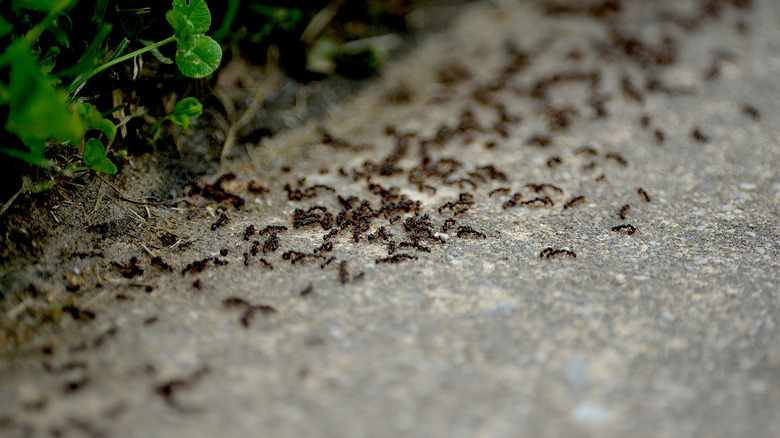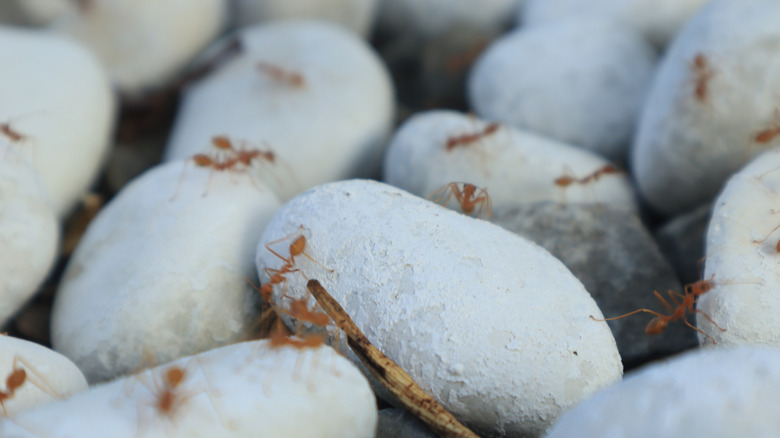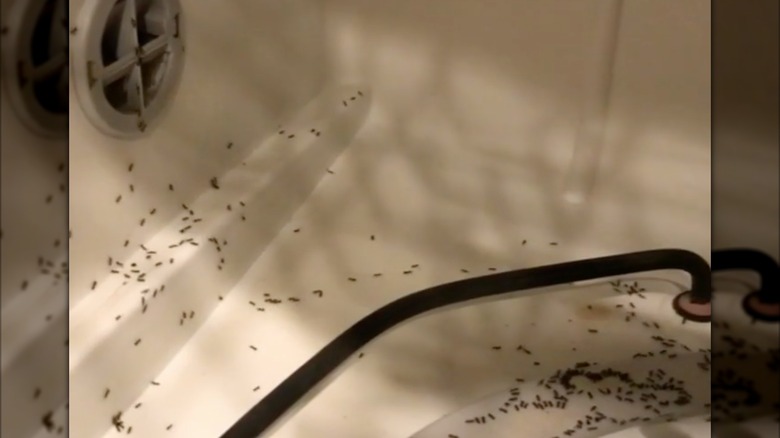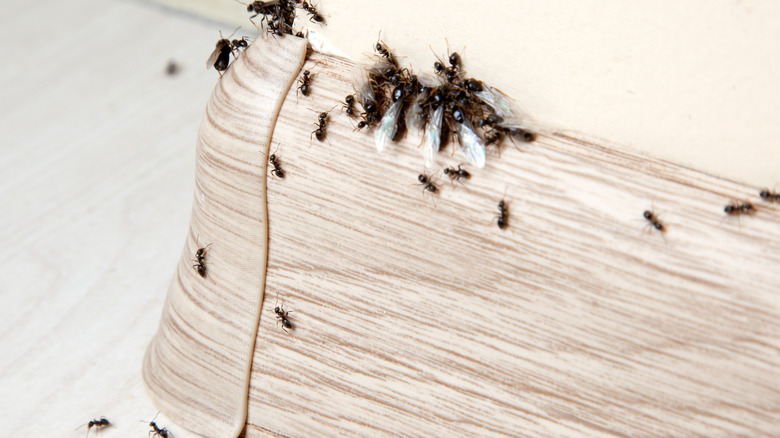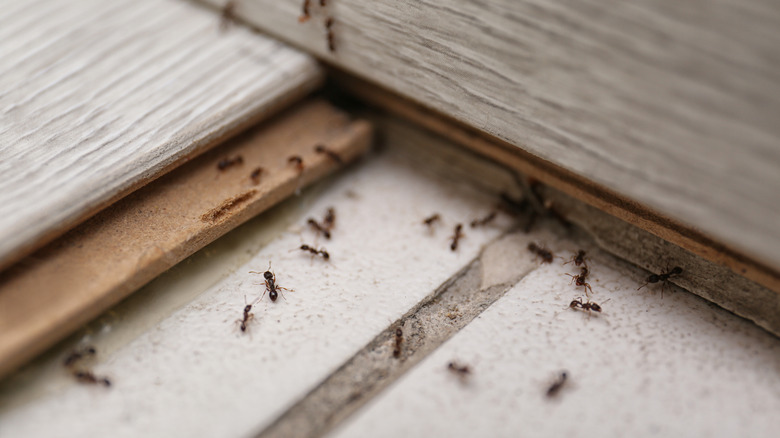The Often Overlooked Areas Of Your Home That May Be Hiding A Nest Of Grease Ants
Are you seeing hundreds of small, yellow or brown ants in your kitchen or backyard, especially during those hot summer months? Then, you most likely have a nest of grease ants. These tiny pests are usually found in kitchens and sinks around small crevices. But that doesn't mean that these nuisances can't find other hiding spots. Therefore, don't forget to check under rocks, inside appliances, behind baseboards, around your foundation, and under your floors as some of the often overlooked areas of your home that may be hiding a nest of grease ants.
So why are these ants so obsessed with your home? Well, a simple reason is food and water. While they prefer hunting near other existing ant colonies to steal their resources, that doesn't mean they won't miss out on the opportunity to dine on the food you have left out as well as make camp in your home. Luckily, there are many ways to get rid of grease ants, including natural measures already in your pantry, store-bought ant bait, and professional pest control services. If you try DIY or purchased methods, make sure to thoroughtly follow the directions. Once you've completed your removal strategy, the surefire way to know the bugs have died is if they are curled up. Afterwards, you'll need to practice preventive measures, especially around the overlooked places.
Under landscape rocks
While looking in your yard, the one grease ant hiding spot you likely keep overlooking is underneath the rocks. Since these ants naturally nest in soil under rocks, it makes sense that they would follow their instincts. And you can't forget about landscaping rocks. These areas can be prone to holding standing water and creating moist soil, the perfect nesting grounds for grease ants. Therefore, it's important to prevent water from pooling around stones. If you plan on adding decorative rocks to your landscaping, you can ask the contractor to install a fabric liner that acts like a protective barrier as well as helps with overall drainage.
Luckily, you don't have to pick up the rocks to remove these grease ants. Instead, you can use a plant-safe pest killer, like food-grade diatomaceous earth, a chalky white substance that consists of fossilized diatoms that have abrasive properties that break apart insects. All you have to do is sprinkle it around your decorative rocks, plants, and other landscaping items to get rid of these pests. You can place this natural pesticide out as much as needed, especially during summer months when grease ants are the most active.
Inside your kitchen appliances
Are you finding ants in your dishwasher or even your toaster? Unfortunately, appliances of all sizes attract ants. Since these insects prefer hidden nest spots, they may try to build it in obscure places like your smaller counter appliances, especially if they are near a food and water source. Therefore, you should move your appliances around every so often to deter them from being attracted to these spots. You'll also want to clean out these items, like toasters and air fryers, of lingering crumbs and spills.
Your larger appliances, like dishwashers and refrigerators, can have these pesky creepy crawlies hanging around as well. Dishwashers have many different crevices and hidden spots that grease ants can easily find and build a nest in. This kitchen essential has everything these arthropods love, food residue, moisture, and warmth during colder seasons. Clean and fill entry cracks and hidden spots with caulk to ensure ants don't want to enter. While the inside of your refrigerator won't have a nest of them because of its cooler temperatures, the water dispenser is a different story. First, make sure to store food in airtight containers in your refrigerator as well as clean up any spills inside to deter their attraction to the area. If you notice a nest in the water dispenser, you'll need to remove the components and clean them out. Dry the pieces and then reinstall.
Behind the baseboards
As tiny pests, grease ants can easily squeeze behind your baseboards, especially if there is a loose board or exposed cracks, and build a nest. An easy way to determine where the nest is in your baseboards is to follow the ant trail. Once you get to the end of the path, you'll know that's the spot you need to focus on. Follow the directions of your chosen removal method and implement it. However, it doesn't end there.
You'll need to also make sure to include preventive measures, including cleaning, sealing, and spraying of natural pest control solutions. First, you'll need to thoroughly clean the baseboards with whatever cleaning solution you prefer. Once clean, grab your board glue or chalk and seal any crevices as well as fix any broken spots. Now that the area is clean, fixed, and free of pests, it's time to keep them away. A natural prevention strategy is to spray essential oil around your baseboards, like peppermint, lemon, tea tree, lavender, cinnamon, and eucalyptus. You'll mix 10 drops of your oil with 1 cup of water and a splash of dish soap in a spray bottle. Once combined, spray on your baseboards after you clean. You can also try store-bought measures or contact a professional team.
Around your foundation
An exterior spot you may overlook while hunting for these ants is your home's foundation. With the smallest of crevices and cracks, they will squeeze through and build a nest. And soon, you'll find the whole area infested with these nuisances with no plans on stopping. The moment you spot this scene, you need to take care of the issue right away. Start by using exterior ant baits or pesticides. Larger or more difficult cases should have a professional assess the area. Once the nest has died out, clean the area and seal any entry points you've seen. However, this isn't the only thing to worry about near your foundation.
Did you know that you could be secretly attracting ants into your home by having plants too close to your foundation? In some cases, grease ants can use your plants as a stepping stool to reach higher foundation cracks and crevices to get inside as well as find it a good nesting spot. Therefore, it is imperative to give your foundation space before planting anything nearby. Depending on the size of the plant, this space can range from 2 to 6 feet. Always review the planting and care directions before growing anything. If you already have plants near your foundation, make sure to use food-grade diatomaceous earth to destroy any nests and lingering pests and then seal up all the entry points you see.
Under the floorboards
Since food crumbs and spills happen to end up on the floor, it's a no-brainer that these small pests would be there. But when you sweep and mop, it doesn't stop them. Instead, these bugs may have found a way to shimmy under your floorboards. There's no need to pry apart your boards to target the nest. Instead, follow the trails they leave behind. Just make sure to spray this path with vinegar to deter any other ants from following lingering pheromone trails in the future. For deeper infestations, you'll want to consult a professional pest control team to ensure the nest is fully gone.
Once the infestation disappears, it is crucial for you to keep up with cleaning and maintaining your floors. This includes wiping up spills and food messes right away. You also shouldn't leave opened food packages or bags on the floor in your pantry. To ensure they never go under your floorboards again, make sure to fill in any cracks or gaps as well as glue down any loose floor trim. If you're worried about grease ants coming back, you can also spray essential oils or drop some on the mop pad as you clean.
